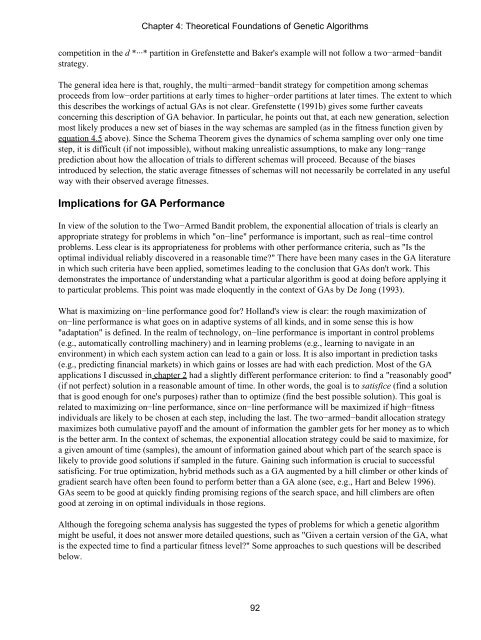An Introduction to Genetic Algorithms - Boente
An Introduction to Genetic Algorithms - Boente
An Introduction to Genetic Algorithms - Boente
You also want an ePaper? Increase the reach of your titles
YUMPU automatically turns print PDFs into web optimized ePapers that Google loves.
competition in the d *···* partition in Grefenstette and Baker's example will not follow a two−armed−bandit<br />
strategy.<br />
The general idea here is that, roughly, the multi−armed−bandit strategy for competition among schemas<br />
proceeds from low−order partitions at early times <strong>to</strong> higher−order partitions at later times. The extent <strong>to</strong> which<br />
this describes the workings of actual GAs is not clear. Grefenstette (1991b) gives some further caveats<br />
concerning this description of GA behavior. In particular, he points out that, at each new generation, selection<br />
most likely produces a new set of biases in the way schemas are sampled (as in the fitness function given by<br />
equation 4.5 above). Since the Schema Theorem gives the dynamics of schema sampling over only one time<br />
step, it is difficult (if not impossible), without making unrealistic assumptions, <strong>to</strong> make any long−range<br />
prediction about how the allocation of trials <strong>to</strong> different schemas will proceed. Because of the biases<br />
introduced by selection, the static average fitnesses of schemas will not necessarily be correlated in any useful<br />
way with their observed average fitnesses.<br />
Implications for GA Performance<br />
Chapter 4: Theoretical Foundations of <strong>Genetic</strong> <strong>Algorithms</strong><br />
In view of the solution <strong>to</strong> the Two−Armed Bandit problem, the exponential allocation of trials is clearly an<br />
appropriate strategy for problems in which "on−line" performance is important, such as real−time control<br />
problems. Less clear is its appropriateness for problems with other performance criteria, such as "Is the<br />
optimal individual reliably discovered in a reasonable time?" There have been many cases in the GA literature<br />
in which such criteria have been applied, sometimes leading <strong>to</strong> the conclusion that GAs don't work. This<br />
demonstrates the importance of understanding what a particular algorithm is good at doing before applying it<br />
<strong>to</strong> particular problems. This point was made eloquently in the context of GAs by De Jong (1993).<br />
What is maximizing on−line performance good for? Holland's view is clear: the rough maximization of<br />
on−line performance is what goes on in adaptive systems of all kinds, and in some sense this is how<br />
"adaptation" is defined. In the realm of technology, on−line performance is important in control problems<br />
(e.g., au<strong>to</strong>matically controlling machinery) and in learning problems (e.g., learning <strong>to</strong> navigate in an<br />
environment) in which each system action can lead <strong>to</strong> a gain or loss. It is also important in prediction tasks<br />
(e.g., predicting financial markets) in which gains or losses are had with each prediction. Most of the GA<br />
applications I discussed in chapter 2 had a slightly different performance criterion: <strong>to</strong> find a "reasonably good"<br />
(if not perfect) solution in a reasonable amount of time. In other words, the goal is <strong>to</strong> satisfice (find a solution<br />
that is good enough for one's purposes) rather than <strong>to</strong> optimize (find the best possible solution). This goal is<br />
related <strong>to</strong> maximizing on−line performance, since on−line performance will be maximized if high−fitness<br />
individuals are likely <strong>to</strong> be chosen at each step, including the last. The two−armed−bandit allocation strategy<br />
maximizes both cumulative payoff and the amount of information the gambler gets for her money as <strong>to</strong> which<br />
is the better arm. In the context of schemas, the exponential allocation strategy could be said <strong>to</strong> maximize, for<br />
a given amount of time (samples), the amount of information gained about which part of the search space is<br />
likely <strong>to</strong> provide good solutions if sampled in the future. Gaining such information is crucial <strong>to</strong> successful<br />
satisficing. For true optimization, hybrid methods such as a GA augmented by a hill climber or other kinds of<br />
gradient search have often been found <strong>to</strong> perform better than a GA alone (see, e.g., Hart and Belew 1996).<br />
GAs seem <strong>to</strong> be good at quickly finding promising regions of the search space, and hill climbers are often<br />
good at zeroing in on optimal individuals in those regions.<br />
Although the foregoing schema analysis has suggested the types of problems for which a genetic algorithm<br />
might be useful, it does not answer more detailed questions, such as "Given a certain version of the GA, what<br />
is the expected time <strong>to</strong> find a particular fitness level?" Some approaches <strong>to</strong> such questions will be described<br />
below.<br />
92






